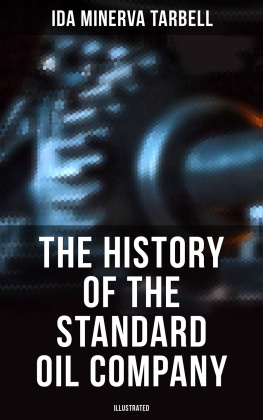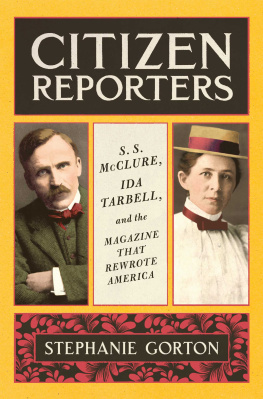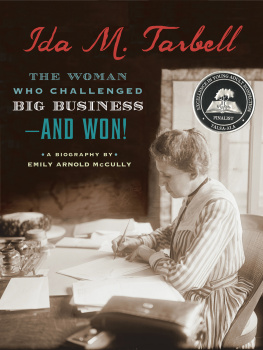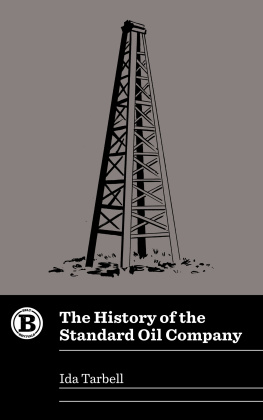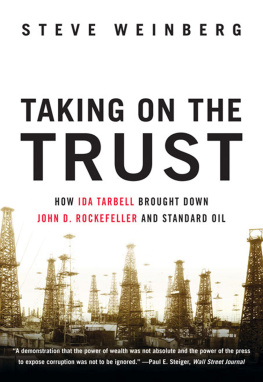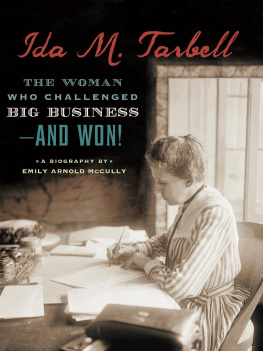Ida Minerva Tarbell - The History of the Standard Oil Company (Illustrated)
Here you can read online Ida Minerva Tarbell - The History of the Standard Oil Company (Illustrated) full text of the book (entire story) in english for free. Download pdf and epub, get meaning, cover and reviews about this ebook. year: 2019, publisher: Musaicum Books, genre: Non-fiction. Description of the work, (preface) as well as reviews are available. Best literature library LitArk.com created for fans of good reading and offers a wide selection of genres:
Romance novel
Science fiction
Adventure
Detective
Science
History
Home and family
Prose
Art
Politics
Computer
Non-fiction
Religion
Business
Children
Humor
Choose a favorite category and find really read worthwhile books. Enjoy immersion in the world of imagination, feel the emotions of the characters or learn something new for yourself, make an fascinating discovery.
- Book:The History of the Standard Oil Company (Illustrated)
- Author:
- Publisher:Musaicum Books
- Genre:
- Year:2019
- Rating:3 / 5
- Favourites:Add to favourites
- Your mark:
- 60
- 1
- 2
- 3
- 4
- 5
The History of the Standard Oil Company (Illustrated): summary, description and annotation
We offer to read an annotation, description, summary or preface (depends on what the author of the book "The History of the Standard Oil Company (Illustrated)" wrote himself). If you haven't found the necessary information about the book — write in the comments, we will try to find it.
The History of the Standard Oil Company (Illustrated) — read online for free the complete book (whole text) full work
Below is the text of the book, divided by pages. System saving the place of the last page read, allows you to conveniently read the book "The History of the Standard Oil Company (Illustrated)" online for free, without having to search again every time where you left off. Put a bookmark, and you can go to the page where you finished reading at any time.
Font size:
Interval:
Bookmark:
THE BIRTH OF AN INDUSTRY
PETROLEUM FIRST A CURIOSITY AND THEN A MEDICINE DISCOVERY OF ITS REAL VALUE THE STORY OF HOW IT CAME TO BE PRODUCED IN LARGE QUANTITIES GREAT FLOW OF OIL SWARM OF PROBLEMS TO SOLVE STORAGE AND TRANSPORTATION REFINING AND MARKETING RAPID EXTENSION OF THE FIELD OF OPERATION WORKERS IN GREAT NUMBERS WITH PLENTY OF CAPITAL COSTLY BLUNDERS FREQUENTLY MADE BUT EVERY DIFFICULTY BEING MET AND OVERCOME THE NORMAL UNFOLDING OF A NEW AND WONDERFUL OPPORTUNITY FOR INDIVIDUAL ENDEAVOUR
One of the busiest corners of the globe at the opening of the year 1872 was a strip of Northwestern Pennsylvania, not over fifty miles long, known the world over as the Oil Regions. Twelve years before this strip of land had been but little better than a wilderness; its chief inhabitants the lumbermen, who every season cut great swaths of primeval pine and hemlock from its hills, and in the spring floated them down the Allegheny River to Pittsburg. The great tides of Western emigration had shunned the spot for years as too rugged and unfriendly for settlement, and yet in twelve years this region avoided by men had been transformed into a bustling trade centre, where towns elbowed each other for place, into which three great trunk railroads had built branches, and every foot of whose soil was fought for by capitalists. It was the discovery and development of a new raw product, petroleum, which had made this change from wilderness to market-place. This product in twelve years had not only peopled a waste place of the earth, it had revolutionised the world's methods of illumination and added millions upon millions of dollars to the wealth of the United States.
Petroleum as a curiosity, and indeed in a small way as an article of commerce, was no new thing when its discovery in quantities called the attention of the world to this corner of Northwestern Pennsylvania. The journals of many an early explorer of the valleys of the Allegheny and its tributaries tell of springs and streams the surfaces of which were found covered with a thick oily substance which burned fiercely when ignited and which the Indians believed to have curative properties. As the country was opened, more and more was heard of these oil springs. Certain streams came to be named from the quantities of the substance found on the surface of the water, as "Oil Creek" in Northwestern Pennsylvania, "Old Greasy" or Kanawha in West Virginia. The belief in the substance as a cure-all increased as time went on and in various parts of the country it was regularly skimmed from the surface of the water as cream from a pan, or soaked up by woollen blankets, bottled, and peddled as a medicine for man and beast.
Up to the beginning of the 19th century no oil seems to have been obtained except from the surfaces of springs and streams. That it was to be found far below the surface of the earth was discovered independently at various points in Kentucky, West Virginia, Ohio and Pennsylvania by persons drilling for salt-water to be used in manufacturing salt. Not infrequently the water they found was mixed with a dark-green, evil-smelling substance which was recognised as identical with the well-known "rock-oil." It was necessary to rid the water of this before it could be used for salt, and in many places cisterns were devised in which the brine was allowed to stand until the oil had risen to the surface. It was then run into the streams or on the ground. This practice was soon discovered to be dangerous, so easily did the oil ignite. In several places, particularly in Kentucky, so much oil was obtained with the salt-water that the wells had to be abandoned. Certain of these deserted salt wells were opened years after, when it was found that the troublesome substance which had made them useless was far more valuable than the brine the original drillers sought.
Naturally the first use made of the oil obtained in quantities from the salt wells was medicinal. By the middle of the century it was without doubt the great American medicine. "Seneca Oil" seems to have been the earliest name under which petroleum appeared in the East. It was followed by a large output of Kentucky petroleum sold under the name "American Medicinal Oil." Several hundred thousand bottles of this oil are said to have been put up in Burkesville, Kentucky, and to have been shipped to the East and to Europe. The point at which the business of bottling petroleum for medicine was carried on most systematically and extensively was Pittsburg. Near that town, at Tarentum in Alleghany County, were located salt wells owned and operated in the forties by Samuel M. Kier. The oil which came up with the salt-water was sufficient to be a nuisance, and Mr. Kier sought a way to use it. Believing it had curative qualities he began to bottle it. By 1850 he had worked up this business until "Kier's Petroleum, or Rock-Oil" was sold all over the United States. The crude petroleum was put up in eight-ounce bottles wrapped in a circular setting forth in good patent-medicine style its virtues as a cure-all, and giving directions about its use. While it was admitted to be chiefly a liniment it was recommended for cholera morbus, liver complaint, bronchitis and consumption, and the dose prescribed was three teaspoonfuls three times a day! Mr. Kier's circulars are crowded with testimonials of the efficacy of rock-oil, dated anywhere between 1848 and 1853. Although his trade in this oil was so extensive he was not satisfied that petroleum was useful only as a medicine. He was interested in it as a lubricator and a luminant. That petroleum had the qualities of both had been discovered at more than one point before 1850. More than one mill-owner in the districts where petroleum had been found was using it in a crude way for oiling his machines or lighting his works, but though the qualities of both lubricator and luminant were present, the impurities of the natural oil were too great to make its use general. Mr. Kier seems to have been the first man to have attempted to secure an expert opinion as to the possibility of refining it. In 1849 he sent a bottle of oil to a chemist in Philadelphia, who advised him to try distilling it and burning it in a lamp. Mr. Kier followed the advice, and a five-barrel still which he used in the fifties for refining petroleum is still to be seen in Pittsburg. His trade in the oil he produced at his little refinery was not entirely local, for in 1858 we find him agreeing to sell to Joseph Coffin of New York at 62-1/2 cents a gallon 100 barrels of "carbon oil that will burn in the ordinary coal-oil lamp."
Although Mr. Kier seems to have done a good business in rock-oil, neither he nor any one else up to this point had thought it worth while to seek petroleum for its own sake. They had all simply sought to utilise what rose before their eyes on springs and streams or came to them mixed with the salt-water for which they drilled. In 1854, however, a man was found who took rock-oil more seriously. This man was George H. Bissell, a graduate of Dartmouth College, who, worn out by an experience of ten years in the South as a journalist and teacher, had come North for a change. At his old college the latest curiosity of the laboratory was shown him the bottle of rock-oil and the professor contended that it was as good, or better, than coal for making illuminating oil. Bissell inquired into its origin, and was told that it camefrom oil springs located in Northwestern Pennsylvania on the farm of a lumber firm, Brewer, Watson and Company. These springs had long yielded a supply of oil which was regularly collected and sold for medicine, and was used locally by mill-owners for lighting and lubricating purposes.
Bissell seems to have been impressed with the commercial possibilities of the oil, for he at once organised a company, the Pennsylvania Rock-Oil Company, the first in the United States, and leased the lands on which these oil springs were located. He then sent a quantity of the oil to Professor Silliman of Yale College, and paid him for analysing it. The professor's report published and received general attention. From the rock-oil might be made as good an illuminant as any the world knew. It also yielded gas, paraffine, lubricating oil. "In short," declared Professor Silliman, "your company have in their possession a raw material from which, by simple and not expensive process, they may manufacture very valuable products. It is worthy of note that my experiments prove that nearly the whole of the raw product may be manufactured without waste, and this solely by a well-directed process which is in practice in one of the most simple of all chemical processes."
Font size:
Interval:
Bookmark:
Similar books «The History of the Standard Oil Company (Illustrated)»
Look at similar books to The History of the Standard Oil Company (Illustrated). We have selected literature similar in name and meaning in the hope of providing readers with more options to find new, interesting, not yet read works.
Discussion, reviews of the book The History of the Standard Oil Company (Illustrated) and just readers' own opinions. Leave your comments, write what you think about the work, its meaning or the main characters. Specify what exactly you liked and what you didn't like, and why you think so.

